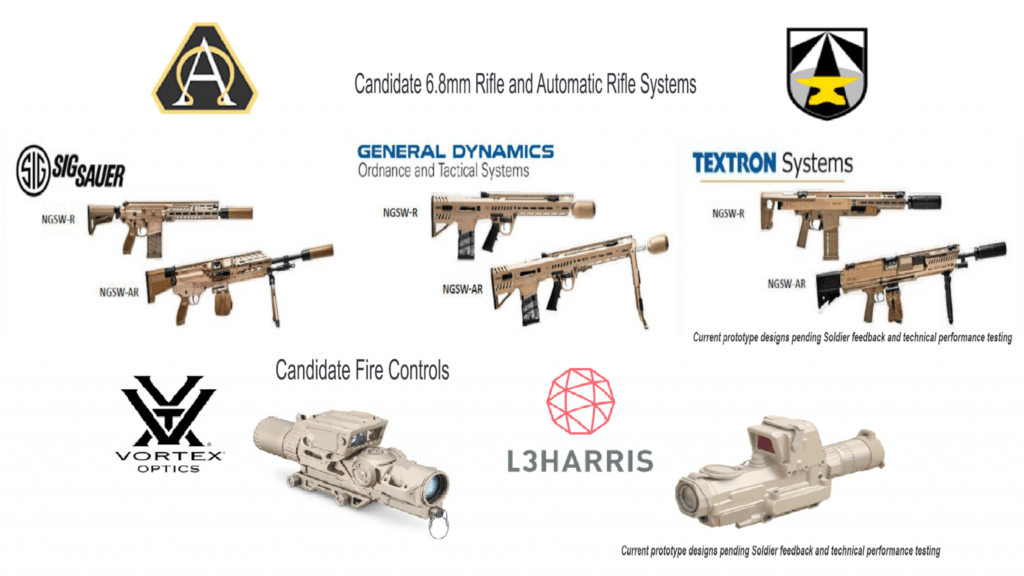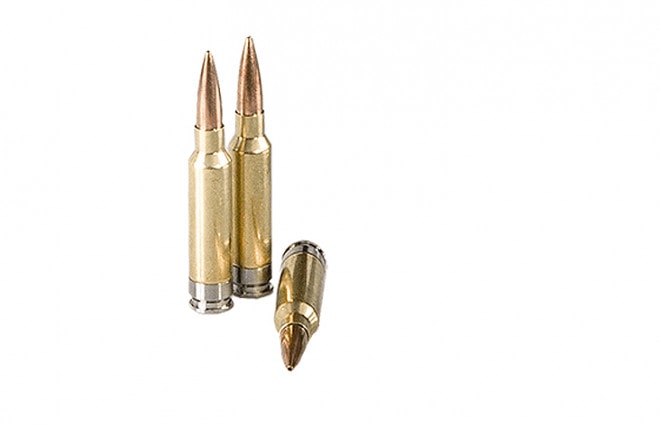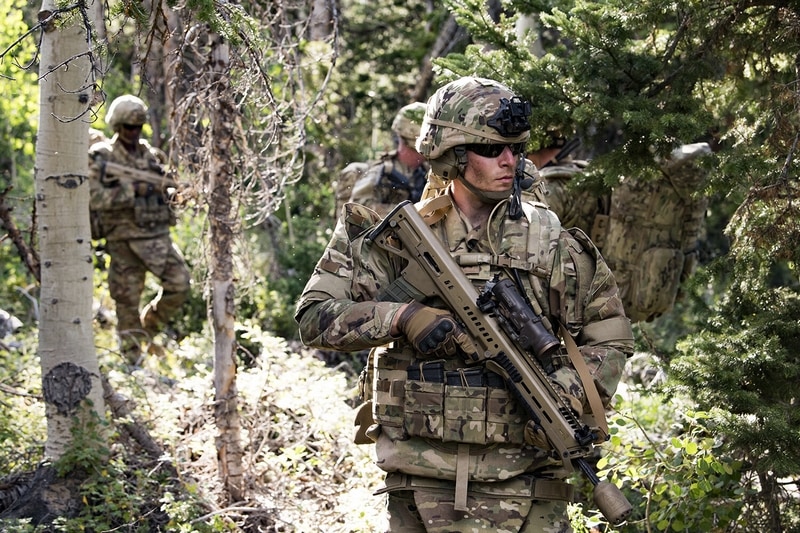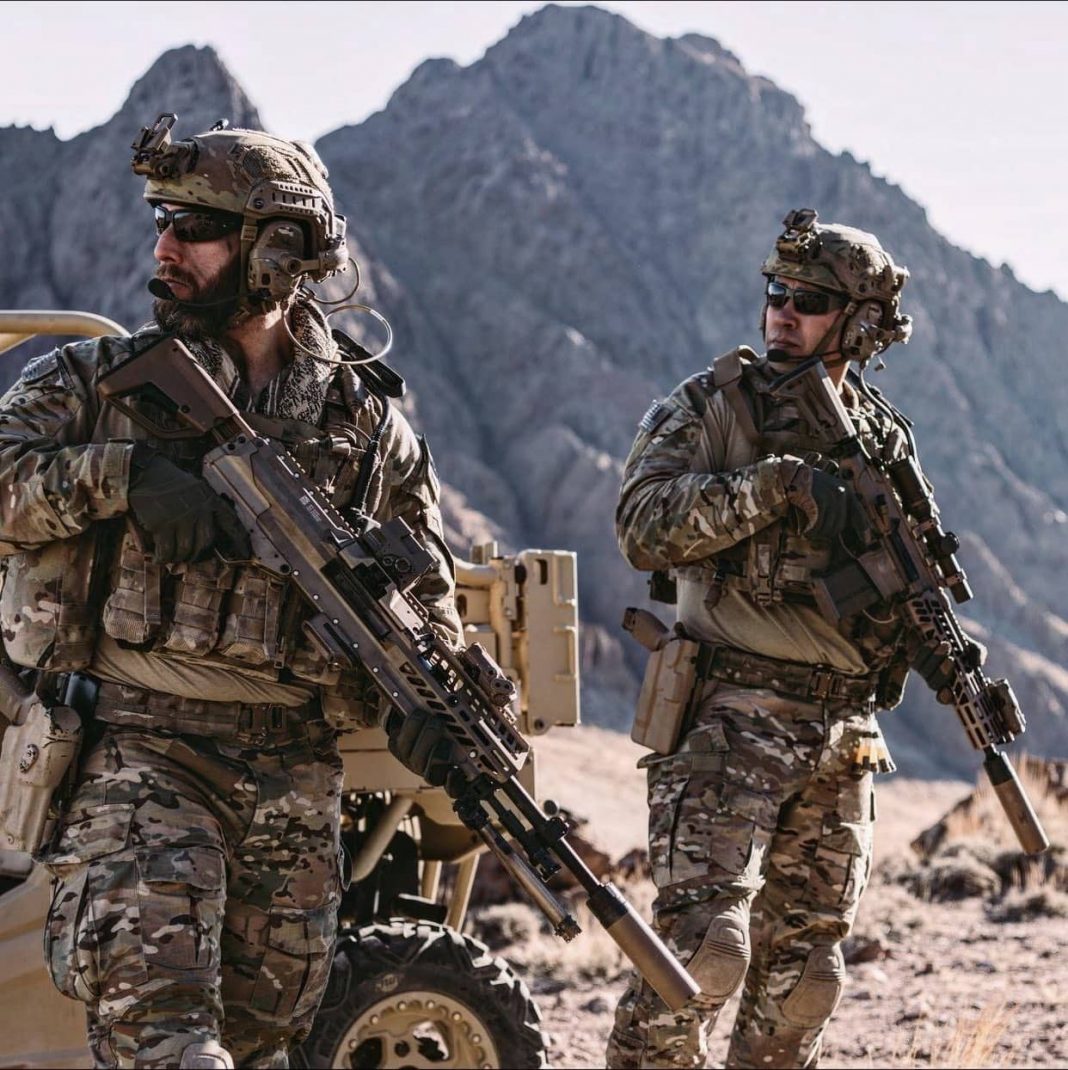1. Summary
The Next Generation Squad Weapons (NGSW) are pair of rifles and light machine guns in a new, heavier calibre designed to replace the US Army’s ageing M4s and M249s. In 2019 the US Army began soliciting contractors for a new family of weapons systems known as the NGSW. After three years of testing, Sig Sauer won the contract to produce their design. The SIG Sauer XM5 and XM250 would fire a much more potent 6.8x51mm cartridge. The weapon systems provide soldiers with increased capabilities at the cost of increased weight and decreased ammunition capacity. The weapon systems will now become the US Army’s standard-issue weapons starting in 2023.

2. The Next Generation Squad Weapon Trials
In early 2019The prototype project opportunity notice (PPON) for the Next Generation, Squad Weapon was issued. Initially, there were multiple entrants in the competition to fill the US Army’s request. However, the competition was narrowed down to just three corporations:
- SIG Sauer
- General Dynamics
- Textron Systems
The purpose of the NGSW program was to replace both the M4 carbine and M249 light machine gun (LMG). The program called for:
- A new carbine (NGSW-R) and LMG (NGSW-AR) with similar control schemes.
- Both must fire a new cartridge with better performance than the 7.62x51mm round.
- The weapons must come standard with a sound suppressor and a smart optical system.
- The XM250 must weigh less than 12 pounds with a sling, bipod, and sound suppressor.
The goal of the Next Generation Squad Weapon program was to provide soldiers with weapons with a greater maximum effective range and body armour penetration capabilities. These goals were derived from lessons learned in Afghanistan where engagements would exceed the maximum range of the M4’s 5.56x45mm cartridge and the proliferation in body armour usage by enemies. Testing began in late 2020 and lasted 27 months in total. The US Army required potential contractors to provide:
- 53 NGSW-R weapons
- 43 NGSW-AR weapons
- 845,000 rounds of ammunition
- Spare parts
- Test barrels
- Tools/gauges/accessories
- Engineering support
- Iterative prototyping efforts
Ultimately, SIG Sauer won the contract to provide the XM5 and XM250 and the XM157 optic contract was awarded to Vortex Optics. The initial contract is worth US$20.4 million and calls for 17,164 XM157 fire control modules, 1,704 XM250 automatic rifles and 16,348 XM5 carbines. (Source, Source, Source, Source, Source)

3. The Sig Sauer XM5
Initially, the XM5 appears to be a beefed-up version of SIG Sauer’s MCX family of rifles seen in use by units like DEVGRU, Delta, and the UK’s CTSFO. However, there are a few key differences between a standard MCX and the XM5. Primarily the weapon has been scaled up from 5.56x45mm to 6.8x51mm. Additionally, the XM5 has a second non-reciprocating charging handle on the left side of the receiver. The XM5 carbine is often referred to as the “XM5 rifle”. However, the US military’s designation as the XM5 indicates it is the iterative replacement to the M4 carbine rather than the M16 rifle. The XM5 provides much greater capability than the legacy M4/M16 family of rifles. However, this performance comes with the significant cost of additional weight and a reduction in ammunition capacity. (Source)
3.1. The Sig Sauer XM5 Specs
- Select fire
- Short-stroke gas piston operated carbine
- Chambered in 6.8x51mm
- Fed from a 20rd detachable box magazine
- Fully ambidextrous controls
- Free-floated barrel to improve accuracy
- M-LOK handguard with a MIL-STD 1913 top rail – the handguard enables the end-user to easily install grips, lights, and laser aiming modules
- Adjustable and foldable stock
- Adjustable gas regulator to improve reliability when shooting with/without the provided suppressor
- Weight: 4.46kg (9.84lbs) with the suppressor
- Barrel length: 343mm (13.5in) – 25.4mm (1in) shorter than the M4’s barrel
- Overall length: 914.4mm (36in) from stock to suppressor

4. The Sig Sauer XM250
Unlike the XM5, the XM250 is a completely new design and not derived from an existing family of weapons. The XM250 is replacing the M249 Squad Automatic Weapon (SAW). However, the new cartridge makes the XM250 more in line with a replacement for the M240 medium machine gun. Unlike the M240 or M249, the XM250 does not have a quick-change barrel. A feature common among belt-fed weapons due to the potential of barrel burnout from sustained high rates of fire. The XM250’s lack of a quick-change barrel relegates it to a light support weapon role.
The XM250 does not appear to have the capability to feed on box magazines. The M249 can use 30rnd M4 magazines, however, the M249 cycles faster than M4 magazines can present the round for feeding. This often results in the weapon jamming or failing to feed. It is interesting, but not shocking, to see that this wasn’t included in the XM250’s design. The XM250 has a significantly longer barrel than the XM5 which should provide slightly greater velocity and terminal ballistics. (Source)
4.1. The Sig Sauer XM250 Specs
- Short-stroke gas piston operated light machine gun
- Fires from an open bolt
- Fed from 50/100/200rd disintegrating belts
- Chambered in 6.8x51mm
- Free-floated barrel
- M-LOK handguard with a MIL-STD 1913 top rail
- Adjustable stock
- Adjustable gas regulator
- Integral bipod to aid in stability when firing from the prone or stationary positions
- Weight: 6.57kg (14.5lbs) with the suppressor
- Barrel length: 190.5mm (17.5in)
- Overall length: 1063.5mm (41.87in) with the suppressor
5. The Vortex Optics XM157
Not much is currently known about the XM157 Fire Control System besides some basic features. Essentially, if you duct tape a variable zoom scope, laser aiming module, calculator, and a range finder together you get the XM157. When looking through the optic the user will be able to project a variety of information into their magnified view. Subsequently, this provides the user of the Next Generation Squad Weapon systems the ability to make first shot hits more reliably. However, if this will truly be useful to the average infantryman while engaged in intense firefights is yet to be seen. No official weight has been published for the XM157 however, it is highly likely that it is heavy, possible in the 1-1.5kg (2-3lbs) range.
5.1. The Vortex Optics XM157 Specs
- 1-8x variable magnification scope with an illuminated etched reticle
- Laser rangefinder
- Internal ballistic calculator
- Atmospheric sensor suite
- Compass
- Infrared aiming laser for use with night vision
- Digital display overlay
The XM157’s variable magnification and integrated electronic systems provide soldiers with significantly increased capabilities when compared to older optic designs. However, the optic is going to add a significant amount of weight to the already heavy systems. Additionally, it is unclear how useful some of its digital systems will prove to be. (Source)
5.2. Background on The Vortex Optics XM157
The XM157 is produced by Vortex Optics, a brand typically known for making affordable consumer-grade optics. However, Vortex’s Razor HD Gen 2 scope, a simple 1-6x magnification optic, has seen use by various units in SOCOM in recent years. As a result, it is likely this unofficial adoption assisted Vortex in getting its foot in the door.

6. The Next Generation Squad Weapon Cartridge
The Next Generation Squad Weapon systems were designed with the usage of a new cartridge known as 6.8x51mm aka .277 Fury.
6.1. The Pressure
First off, this cartridge is truly deserving of the moniker “Fury”. The 6.8x51mm has a chamber pressure of 80,000 psi. By comparison, the US Army currently uses the M855A1 5.56x45mm round in its M4s and M249s. The M855A1 is known for burning out barrels quickly due to its high chamber pressure of 51,522 psi. It really can’t be emphasized enough how ridiculously high the pressure of the 6.8x51mm cartridge is. The 6.8x51mm features a hybrid three-part case design:
- Traditional brass upper casing – expands against the chamber creating a gas seal.
- Steel alloy base – helps contain the high pressures and prevent rupture of the brass case.
- Internal locking washer – secures the two pieces.
The case is designed this way to prevent rupturing from the incredibly high pressures. Additionally, each hybrid round is supposed to be 23.5% lighter than a traditional fully brass-cased one. (Source)
6.2. Solving Problems
The new cartridge was designed to solve problems US Army leadership saw with the 5.56x45mm and 7.62x51mm rounds. The 5.56mm is an intermediate cartridge meaning it is relatively lightweight but with reduced effective range and terminal ballistics. The 7.62mm is a larger round capable of reaching out to extended ranges with a lot of energy. However, the heavy bullet weight curves the round’s trajectory significantly. The 6.8mm is intended to increase the lethality of soldiers at a longer distance than the 5.56mm while being easier to shoot than 7.62mm thanks to a flatter trajectory.
| Cartridge | Velocity | Energy | Grains | Chamber Pressure |
| 6.8x51mm | 914.4m/s (3000 ft/s) | 3,652 J (2,694 ft⋅lbs) | 135gr | 551 MPa (80,000 psi) |
| 5.56x45mm (M855A1) | 961 m/s (3,150 ft/s) | 1,859 J (1,371 ft⋅lbs) | 62gr | 355 MPa (51,522 psi) |
| 7.62x51mm (M80) | 850 m/s (2,800 ft/s) | 3,470 J (2,559 ft⋅lbs) | 147gr | 415 MPa (60,191 psi) |
6.3. Next Generation Squad Weapon and Body Armor
Penetrating body armour was a key design aspect of the new round. US Army leadership saw the proliferation of body armour amongst near-peer threats and recognized the need for a round with better penetration. An example is Russian Ratnik body armor. The 6.8mm achieves improved penetration by shooting a 135-grain projectile at around 914.4m/s (3000 ft/s) which produces 3,652 J (2,694 ft-lbs) of energy. By comparison, M855A1 fires a 62-grain projectile at 961 m/s (3150 ft/s) with 1,859 J (1,371 ft⋅lbs) of energy. Although the two projectiles have similar velocity, the new 6.8mm round provides much better terminal ballistics due to its mass and the amount of energy it has. (Source, Source)
7. The Dissent Against the Next Generation Squad Weapon
The adoption of a new weapon system would not be complete without heavy criticism levied against it. The Next Generation Squad Weapon systems are no different, although in the case of the XM5 and XM250 they may be somewhat justified. Two major complaints are:
- reduction in ammunition carried
- The increase in weight.
7.1. Deja Vu
In many ways, the switch from the intermediate 5.56mm to a full-power rifle cartridge is seen as a step backwards. In the 1960s the US military adopted the M16 as its primary fighting rifle. Prior to this, the M14 was the military’s main service weapon. The M14 shares some characteristics with the new XM5, primarily they both fire a full-power rifle cartridge, fed from 20-round box magazines. The m14’s 7.62x51mm round provided great range and ballistics much like the 6.8x51mm. However, the M16 was adopted in part because the lighter cartridge allowed soldiers to carry significantly more ammunition. Today a soldier’s standard combat load of ammunition is seven 30rnd magazines for the M4, totalling 210 rounds. An M249 gunner typically carries 600 rounds. The projected loadout for an XM5 is seven 20rnd magazines, totalling 140 rounds. An XM250 gunner will carry 400 rounds of ammunition. (Source)
| Weapon | System Weight | Combat Load Amount | Combat Load Weight | Total Weight |
| XM5 | 3.8 kg (8.38 lbs) | 140 rounds | 4.4 kg (9.8 lbs) | 8.3 kg (18.2 lbs) |
| M4 | 2.9 kg (6.43 lbs) | 210 rounds | 3.3 kg (7.4 lbs) | 6.3 kg (13.8 lbs) |
| XM250 | 6.5 kg (14.5 lbs) | 400 rounds | 12.3 kg (27.1 lbs) | 18.9 kg (41.6 lbs) |
| M249 | 8.1 kg (17.9 lbs) | 600 rounds | 9.4 kg (20.8 lbs) | 17.5 kg (38.7 lbs) |
7.2. The Next Generation Squad Weapon Trade-Off
One can argue that the reduction in ammunition carried is an acceptable tradeoff for the increased range and ballistic capabilities. However, studies have shown that amount of ammunition you can carry is more important than the terminal ballistics of the round being fired.
Major Matthew L. Simon examined 133 different combat engagements ranging from the Korea War to the war in Afghanistan. As a result, he found that soldiers often are required to use multiple rounds to engage multiple targets, often in low visibility conditions and within 50m. The idea of a round that can kill an enemy in one shot is great on paper, but in reality, quantity beats quality. Soldiers are trained to close with and destroy the enemy in combat. Subsequently, this usually requires suppressing the enemy by firing a large volume of bullets, while a manoeuvre element flanks the enemy’s position. Therefore the more ammunition you have, the more effective the suppression is. (Source)
7.3. Manoeuvre Warfare
The ability to lay down a base of fire and manoeuvre on the battlefield is critical to US military doctrine. The Next Generation Squad Weapon systems sacrifice a large chunk of their ability to suppress in favour of increased firepower. Not only do they have reduced capacities, but they also are significantly heavier than their predecessors. The XM157 was designed to increase first shot hit probability. However, during combat, the technical aspects of the system will likely go unused. It would be more practical to carry the digital systems on the body rather than increasing the weight of the gun. The increased weight leads to increased fatigue when soldiers must carry them on long patrols. In many ways, the US Army seems to be forgetting the lessons it has learned in the past.

8. Next Generation Squad Weapon and The Future
The XM5 and XM250 provide the individual soldier with greatly increased capabilities. The new cartridge along with the XM157 Fire Control System allows soldiers to engage targets at much greater ranges. The standard-issue suppressors will greatly reduce the signature of the weapons and aid in command and control on the fireteam level. However, these weapons seem far too specialized to be the primary fighting rifle and light machine gun.
The US Army is in love with the concept of standardization and universal application. Rather than invest in multiple tools for specific jobs, the Army looks for the “jack of all trades”. In some ways, the NGSW trials have flavours of the Universal Camouflage Pattern trials. The US Army is trying to shoehorn the weapon into a universal role rather than diversifying its arsenal. The M16/M4 family of weapons have served the US military incredibly well over the past 60 years. However, only time will tell if the NGSWs will have the same legacy.

